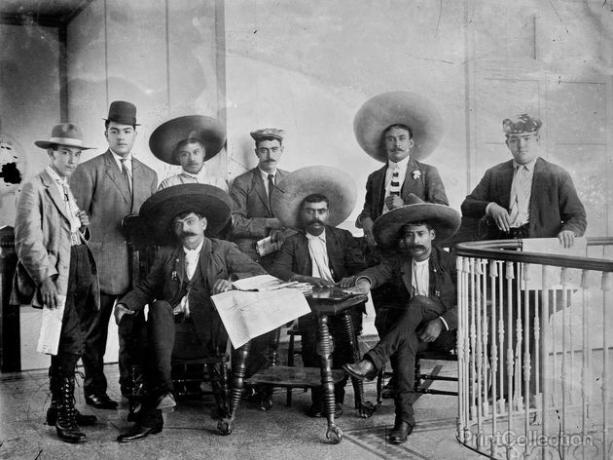THE mexican revolution (1910) was an armed insurrection that took place in Mexico, of a liberal and popular character, formed by dissidents from the government, peasants and indigenous peoples.
It also brought together socialist, liberal and anarchist leaders in the struggle for agrarian reform, nationalization of North American multinationals and for electoral reforms.
Historical Context of the Mexican Revolution

Between 1876 and 1911, President Porfirio Díaz (1830 - 1915) maintained a military dictatorship in Mexico, thanks to clientelism and a series of electoral fraud.
The last of these was held in 1910, when Díaz was re-elected for the last time and caused a dissent among national political elites.
On the other hand, popular ills were aggravated by the economic crisis of 1907. Likewise, the "Lei dos Baldios" of 1893-1902 favored the concentration of land, as it made it possible to take indigenous properties and transfer them to large landowners and foreign investors.
Thus, in 1910, Francisco Ignácio Madero González (1873-1913), presidential candidate defeated in the rigged elections, rose up against the government.
To gain popular support, Madero promises to carry out Agrarian Reform. With the support of the revolutionary armies of Emiliano Zapata and Pancho Villa, Madero was elected president in October 1911.
However, as he does not keep his promise to carry out the Agrarian Reform, Zapata breaks with him. Later, Zapata returns to the south and starts the “Ayala Plan” to divide 1/3 of the land among the peasants.
With no other way out but to continue the Revolution, Emiliano Zapata and Pancho Villa started a new military offensive against Madero.
Likewise, the conservatives, led by General Victoriano Huerta, are against the president. Huerta carried out a coup d'état in 1913, rising to power after assassinating then-President Francisco I. Madero and his deputy.
However, Huerta also suffered from armed uprisings against his government. Northern Governor Carranza teamed up with Southern Emiliano Zapata to defeat him. They also had the support of the US Marines, who took over the port of Vera Cruz.
Huerta is defeated and deposed in June 1914, when Pancho Villa and Zapata took the Government Palace and elected Carranza as the new President. In 1917, the new Constitution that is still in force in Mexico is enacted.
Finally, Zapata is murdered in an ambush in 1919, and Pancho Villa is killed in 1923. With the death of the popular leaders of the Revolution, it weakens and power returns to the hands of the Mexican bourgeoisie.
Causes of the Mexican Revolution

The main causes of the Mexican Revolution are linked to capitalist exploitation and the resulting social injustices.
In effect, the rural aristocracy held control of agricultural production (3% of the population owned the best land in Mexico). For its part, foreign capital exploited mines, ports and oil extraction.
This situation was aggravated by Porfirio Díaz, as his government intensified the exploitation of the less favored population. Likewise, it opened the country to foreign capital, causing discontent on the part of the nationalist elites who supported it.
Consequences of the Mexican Revolution
The main consequence of the Mexican Revolution was the promulgation of the 1917 Constitution, which provides for:
- the right to expropriate land by the State for Agrarian Reform purposes;
- recognition of indigenous rights over ancestral lands;
- the creation of a minimum wage and an eight-hour workday;
- the definitive separation of State and Church.
Another indirect consequence of this movement was the weakening of the caudilloism In Mexico.
Despite all the achievements, many peasants lost their land after the Revolution. Unable to compete with the production made on the large estates, several had to sell them to large landowners.
Emiliano Zapata and Zapatismo
Emiliano Zapata Salazar (1879-1919) was born in the village of San Miguel Anenecuilco and was the main leader of the Liberating Army of the South, with more than thirty thousand soldiers. He is considered the great hero of the Revolution.
Nevertheless, Zapata was one of the most radical figures in the revolutionary movement, due to his desire to carry out agrarian reform and lack of ambition for power. Proof of this is that he did not want to be president in 1914, even when he had the possibility.
Zapata's ideas have survived and inspired Zapatismo, and the creation of the Zapatista National Liberation Army, which struggles to reform the Mexican political system.
Trivia about the Mexican Revolution
- The Mexican Revolution was one of the main themes of the artistic movement called "Mexican Muralism".
- From the 1930s onwards, political elites crystallized revolutionary ideals in the Institutional Revolutionary Party.
- To this day, Emiliano Zapata is one of the best known Mexicans in the country and abroad.
Bibliographic references
Mexican Revolution, a popular revolution. Documentary. Consulted on 05/29/2020.
Mexican Revolution; 109 years ago one of the greatest revolutions of the 20th century began. Adventures in History. Published on 11/19/2019.
Comment the revolution mexicaine a-t-elle répondu aux désirs de changement?. Documentary. Accessed on 05.29.2019.
